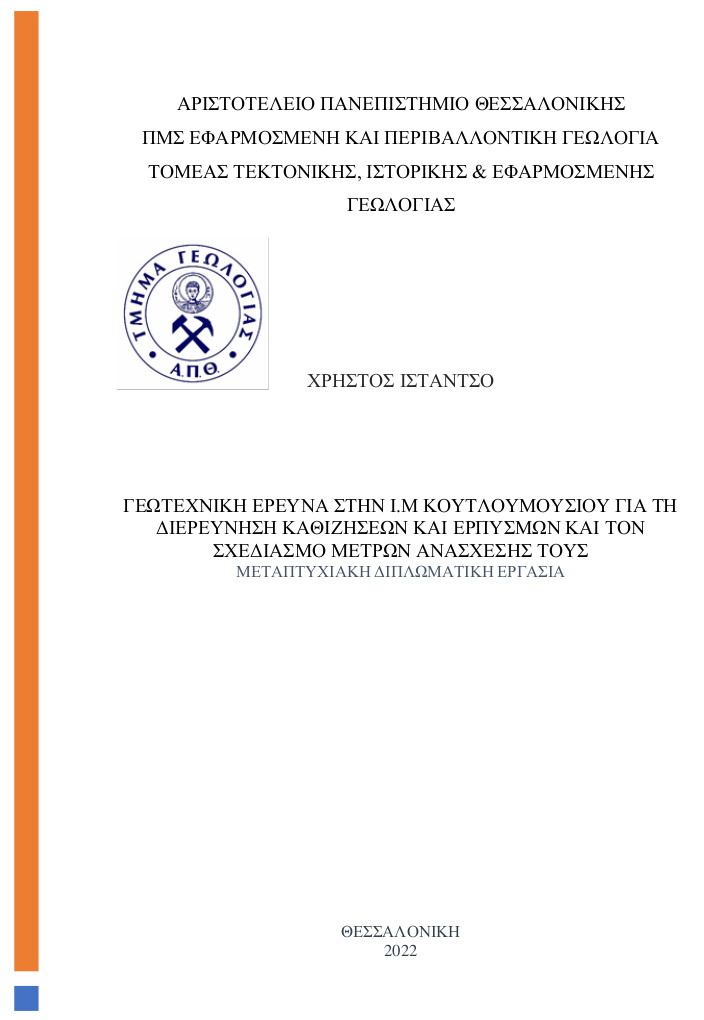
Γεωτεχνική έρευνα στην Ι.Μ. Κουτλουμουσίου για τη διερεύνηση καθιζήσεων και ερπυσμών και τον σχεδιασμό των μέτρων ανάσχεσης τους = Geotechnical survey at the Monastery of Koutloumousi for the investigation of settlements and creeps and the design of counter-measures.
Περίληψη
The maintenance and the restoration of monumental buildings with wide life expectancies require a full and analytical check of their geological and geotechnical data, in order to define the failure mechanisms which are affecting them through time, and also to do a detailed design of countermeasures with life expectancy wider than the common construction projects.In this project, the geological and geotechnical data that were gathered in the area of the Catholic Church of Koutloumousi Monastery are presented and evaluated, in the context of the restoration projects of the Temple’s intense damages, which are due to the failure mechanisms of the foundation sub-soil.The Koutloumousi Monastery is located south-east of Karyes in Agion Oros, in an area of complexed geotechnical conditions which are affecting the wider area with creeping failure mechanisms, soil deformations and settlements. It is therefore, necessary to conduct a detailed survey on these mechanisms, in order to suggest appropriate countermeasures.The geotechnical survey that took place to the Temple of the monastery, which includes the conduct of drillings, in situ and laboratory testing, as well as the results of it are also demonstrated in this project. The results of the survey are then evaluated and take under consideration, previous geotechnical surveys which were conducted in the area of interest in order to define the sub-soil geotechnical units of the foundation and to calculate the characteristic values of geotechnical parameters for each unit. In that manner, the geotechnical model of the sub-soil of the monastery is constructed, and based on it, behavior tests are done against soil deformations and settlements.Finally, the failure mechanism of the foundation sub-soil is determined since the pathology of the Temple is due to differential settlements while including dimensioned proposed countermeasures.
Πλήρες Κείμενο:
PDFΑναφορές
Βλάχος Χ.Βάïος, (2015), ΕΡΓΑΣΤΗΡΙΑΚΗ ΠΡΟΣΟΜΟΙΩΣΗ ΤΩΝ ΣΥΝΘΗΚΩΝ ΔΙΑΤΜΗΣΗΣ ΕΔΑΦΩΝ ΣΕ ΑΚΟΡΕΣΤΕΣ ΣΥΝΘΗΚΕΣ. Θεσσαλονίκη : Μεταπτυχιακή Διατριβή Πανεπ. Θεσσαλονίκης
Βουδούρης Κ., Μαρίνος Β. (2010), Τεχνική Γεωτρήσεων : Κεφάλαιο 5 – Δειγματοληπτικές – Πυρηνοληπτικές Γεωτρήσεις, Θεσσαλονίκη, σελ. 77 – 101
Εθνικής Επιτροπής Υδάτων (ΦΕΚ Β’/1383)
Ελληνικός Αντισεισμικός Κανονισμός, Ε.Α.Κ 2003 (ΦΕΚ 1154Β’, 12-8-2003)
Εφημερίδα της Κυβερνήσεως Σχέδιο Διαχείρισης των Λεκανών Απορροής Ποταμών του Υδατικού Διαμερίσματος Κεντρικής Μακεδονίας, Ειδική Γραμματεία Υδάτων, 2014.
ΙΓΜΕ, Γεωλογικός Χάρτης, Φύλλο Χερσόνησος Άθω, κλ. 1:50.000. – 1978.
Κούκης Γ., Σαμπατακάκης Ν., (2002), Τεχνική Γεωλογία, εκδόσεις Παπασωτηρίου, Αθήνα, σελ. 264 – 300, 315-320, 339-350
Ε105-86 Προδιαγραφές εργαστηριακών δοκιμών εδαφομηχανικής. Αθήνα : ΥΠΕΧΩΔΕ, 1986.
ΕΛΟΤ EN 1997-1 Ευρωκώδικας 7: Γεωτεχνικός σχεδιασμός - Μέρος 1: Γενικοί κανόνες, 2005.
Χρηστάρας Β., (2006), Εργαστηριακές και επί τόπου δοκιμές εδαφομηχανικής. ΤΕΕ (β’εκδ.), Αθήνα, 144 σελ.
Χρηστάρας Β., Χατζηαγγέλου Μ., (2011), Απλά βήματα στην εδαφομηχανική. Εκδόσεις UNIVERSITY STUDIO PRESS, Θεσσαλονίκη, σελ. 131, 151-152.
Ξενόγλωσση Βιβλιογραφία
AASHO (1961). The classification of soils and soil-aggregate mixtures for highway construction purposes. In Standard specifications for highway materials and methods of sampling and testing, 8 th ed., Part 1, Specifications, Am. Assoc. State Highway Officials, pp 45-51.
ASTM (1989). Annual book of ASTM Standards. Sec. 4 Construction, Vol.04.08, Soil and Rock Building Stones, Geotextiles, Philadelphia, 997 p.
ASTM (1983). Standard test method for classification of soils for engineering purposes: Am. Soc. For Testing and Mater., ASTM Designation D 2487-69, Annual book of ASTM standards, Sec. 4, Vol. 04.08, pp. 392-396.
ASTM (1985). Standard test method for classification of soils for engineering purposes: Am. Soc. For Testing and Mater., ASTM Designation D 2487-83, , Annual book of ASTM standards, Sec. 4, Vol. 04.08, pp. 395 – 408.
Bowels J.E, (1997), Foundation Analysis and design, MacGraw-Hill Companies, Inc. Quinta edición. Nueva York.
Casagrande A. (1948). Classification and identification of soils. Am. Soc. Civ. Eng., Trans., Vol. 113, pp. 901 – 930.
Cetin K.O., Seed R.B., Der Kiureghian A., Tokimatsu K., Harder Jr. L.F., Kayen R.E., and Moss R.E.S., (2004), ”SPT-based Probabilistic and Deterministic Assessment of Seismic Soil Liquefaction Potential”, Journal of the Geotechnical and Geoenviromental Engineering , ASCE , Vol. 130, No. 12, pp. 1314-1340.
Dikau R. (1989), The application of a digital relief model to landform analysis, Taylor and Francis, London, pp 51–77
European Standard EN 1998-1:2004 Eurocode 8: Design of structures for earthquake resistance. Part 1: General rules, seismic actions and rules for buildings. Comite Europeen de Normalisation. Brusells.
Hansen J.B., (1970), A revised and extended formula for bearing capacity, Geoteknisk Inst., Bulletin 28, pp. 5-11.
Leroueil S., Magnan J.P & Tavenas, F. (1985). – Remblais sur argiles molles. Tec.-Doc. Lavoisier. Paris, 342 p.
Terzaghi K. (1955), Evaluation of Coefficients of Subgrade Reaction, Geotechnique, Vol. 5, Issue 4, pp. 297 – 326.
Terzaghi K. and Peck, R.B. (1967), Soil Mechanics in Engineering Practice, John Wiley, New York, pp. 729
Ηλεκτρονικά εργαλεία
QGIS 3.12 Bucurest
AutoCAD 2022
Inkscape
Golden Software Surfur 13
Geostru
LoadCap
Microsoft Word
Microsoft Excel
Rocscience Settle3
ΕΓΣΑ87 (GGRS87) coords
Εισερχόμενη Αναφορά
- Δεν υπάρχουν προς το παρόν εισερχόμενες αναφορές.
